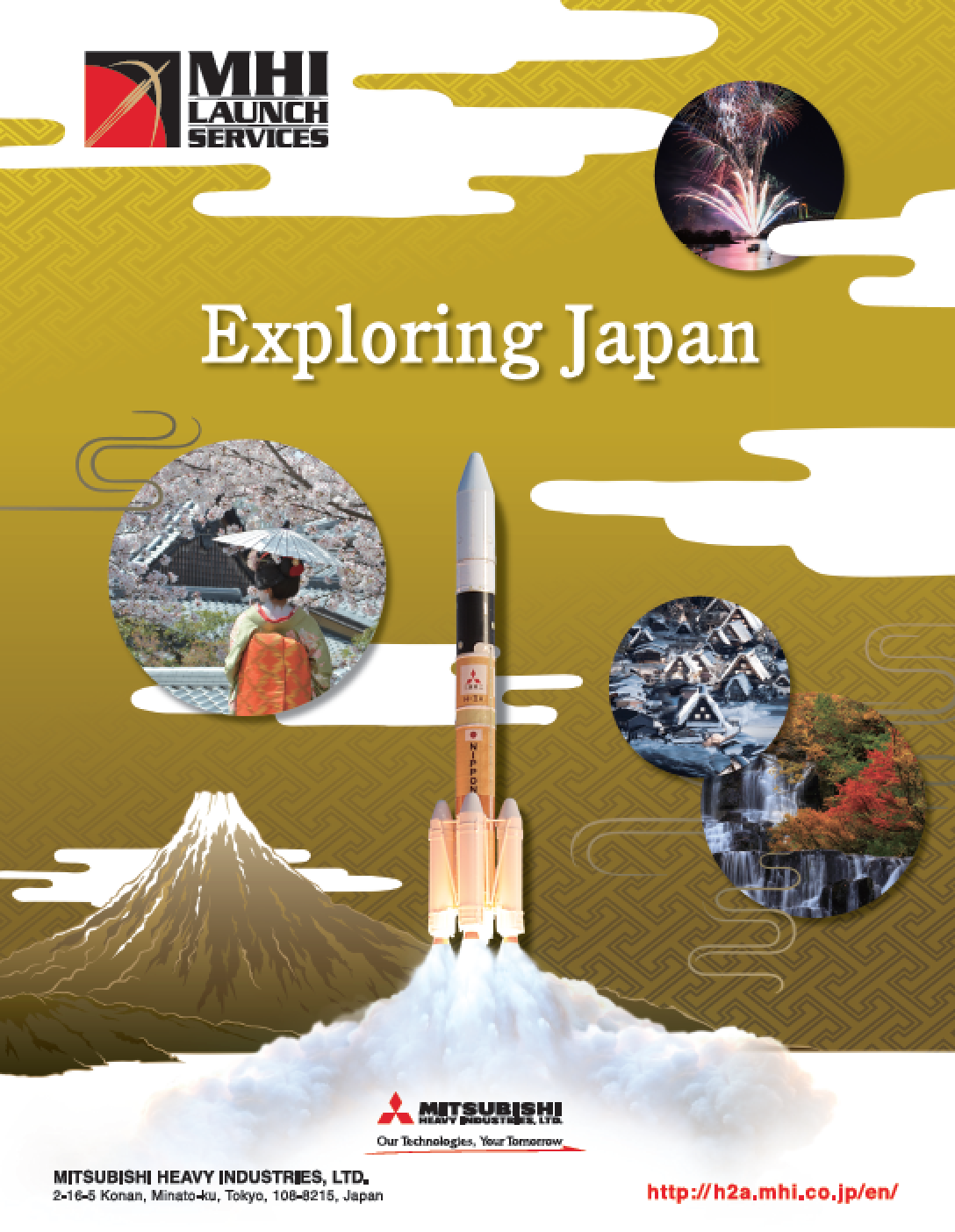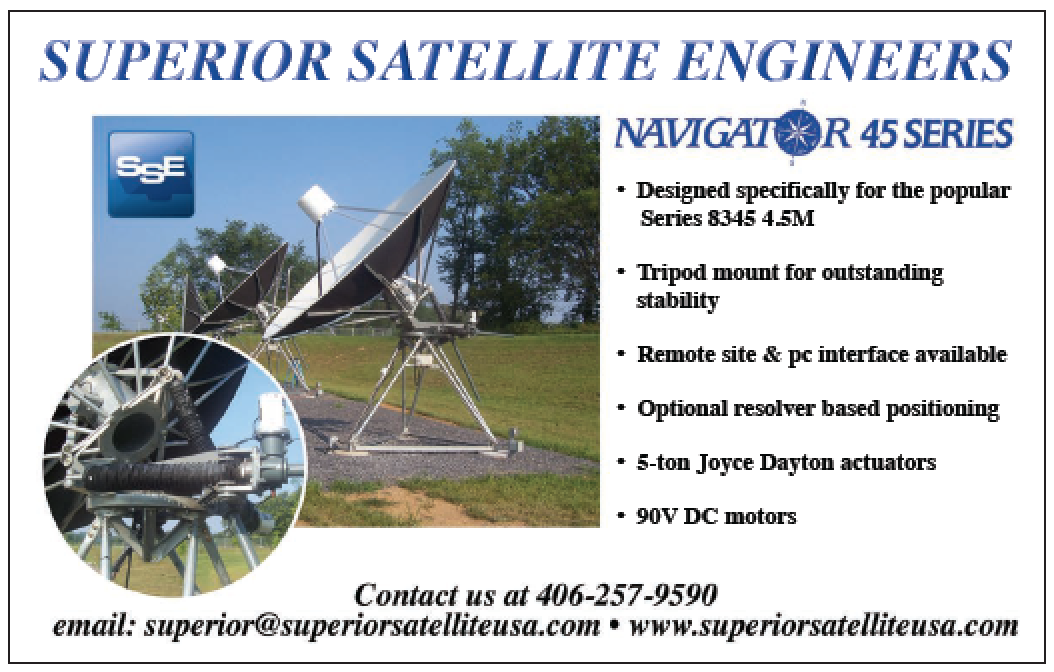Interorbital Systems on a TubeSat Roll
Interorbital Systems (IOS) watched their first TubeSats reach orbit, courtesy of the Japanese HTV-6 rocket and sat-kit builders: an Ubatuba, Brazil Middle School with its Tancredo Sat-1 and OSNSAT from California start-up Open Space Network.
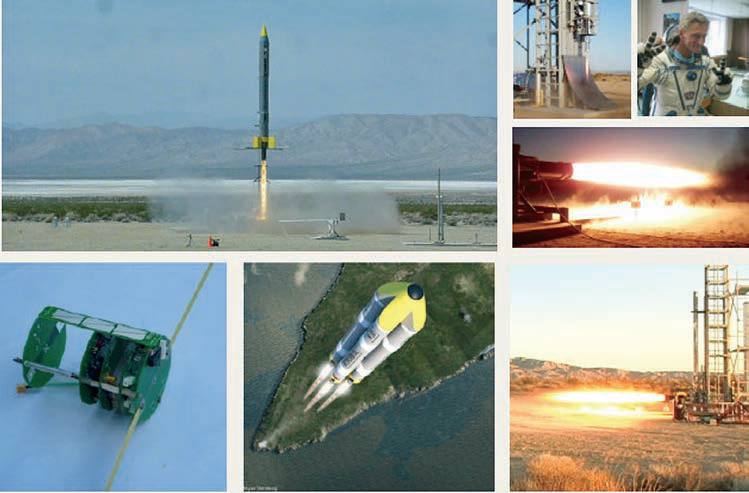
These picosats were derived from the IOS TubeSat Personal Satellite Kit, the ultimate hands-on academic space science tool designed to support STEM and STEAM curricula in US and over 20 countries worldwide.
“These are the first spacecraft elements designed and made in Mojave to go to orbit. The TubeSat kit is one of IOS’ inventions and one of our best–selling products—a teaching tool that instructs the builder to create the world’s least expensive, fully functional satellite,” said IOS Co/Founder and CTO Roderick Milliron.
One of the IOS TubeSats launched to the ISS, Tancredo-1, was built by the Tancredo Middle School, with the mentorship of INPE, and the Brazilian Space Agency. The Ubatuba, Brazil program, is led by educator Candido Moura, an early adopter of Interorbital’s satellite ‘maker’ program.
The TubeSats flew on December 9th, 2016, aboard the Japanese HTV-6 cargo rocket to the International Space Station where it now awaits deployment and activation. The GAUSS organization facilitated the payload placement, and provided the 3-Unit TuPOD, a 3-D-printed
deployer, designed as a kind of P-POD specifically for TubeSats.
The TuPOD was first created as part of a Morehead State University smallsat team led by Professor Bob Twiggs.
Interorbital also offers CubeSat kits, which are equally popular and affordable at a special academic price. The first TubeSat kits hit the market in 2009, and were sold with a launch on a future mission of Interorbital’s NEPTUNE rockets.
The ultra-low cost was offered because Interorbital considered the first of its rocket launches to be high-risk and experimental, but offered a ride-share payload space to LEO, something in short supply to the smallsat community. With 137 small satellites--most of them built from IOS’ own TubeSat and CubeSat kits--on its launch manifest the company anticipates beginning its own orbital launch services when testing and FAA/AST licensing is complete, projected for mid-summer 2017.
The HTV-6 TubeSat mission capped off an eventful 2016 for IOS. In August, Interorbital’s launch contract with Google Lunar X PRIZE Team SYNERGY MOON was verified, sending the team and launch-provider one step closer toward the Moon launch they hope will win the $30 million dollar prize. IOS will fly a super-variant of it NEPTUNE rocket series, the NEPTUNE 8 (N8) LUNA, an eight-module rocket with enhanced performance engines, to launch SYNERGY MOON’s Lunar Lander and Rover at year’s end.
Current lead-up development and testing for the big event includes field testing of all rocket systems and the guidance and control system for the NEPTUNE rocket series.
Upon completion of these final ground tests, IOS will conduct a full-scale vehicle flight test of a guided CPM, as one of the milestones in IOS’ busy launch schedule for 2017. Planned events include a space-altitude suborbital flight of a full-performance CPM, the core module of all its NEPTUNE rockets, followed by its first orbital satellite mission with an N3 (3-module) carrying 15 currently manifested small sats to a 310-km circular polar orbit from an ocean-base off the coast of Southern California.
As 2017 continues, the excitement builds with a lunar-impact mission, designated “Lunar Bullet,” that will feature a lunar-direct trajectory ending with a hard impact on the Moon’s surface, similar to the NASA ‘Ranger’ mission from the 1960s. Not only will the Lunar Bullet be the first payload launched by a commercial rocket company to the surface of the Moon, the IOS/Innovative Orbital Design mission will also serve as a precursor to Interorbital/SYNERGY MOON’s GLXP prize-attempt launch by verifying IOS’ launch and interplanetary navigation technology.
Interorbital’s message for 2017: Moonward!
For more about Interorbital Systems and its program, please see:
Launching Into Space 3.0... An Interorbital Systems Perspective: milsatmagazine.com/story.php?number=1512656321
Randa Milliron, Planetary Society 2017 interview: planetary.org/multimedia/planetary-radio/show/2017/0102-randa-milliron-interorbital.html
AMERGINT Increases Their Capabilities
Eight years ago, AMERGINT began to transform the satellite ground systems market by moving SATCOM processing into software applications.
This objective quickly spread to transforming the spacecraft test, real-time data acquisition and spacelift range markets with the same software application approach. AMERGINT’s SOFTLINK architecture is the single unifying technology that makes this a reality.
The transformative capability and dramatically lower cost of ownership of SOFTLINK applications is driving AMERGINT’s growth and facility expansion needs.
“Four years ago we doubled the size of our facility when we moved to our current location,” noted Sean Conway, AMERGINT’s Chief Operating Officer. “With the completion of our expansion, we are doubling that space yet again to more than thirty thousand square feet.”
The latest addition includes lab space for additional development, integration, test, and support for large projects.
The new facility also includes offices for new employees, as well as facilities to support a broader range of programs and customers in house.
“Customer adoption of our softFEP and satTRAC products has really accelerated in the past few years,” said Rob Andzik, AMERGINT’s President. “Our products are used on many mission critical systems. We understand the importance of the trust placed in us and we are committed to providing the best talent, products, and customer support possible. As a result, we are strategically seeking both experienced engineers and recent college graduates to add to our team. This new expansion gives us the high quality work environment and needed lab space to support our projected growth.”
“As we begin our ninth year, we are tactically focused on delivering technology and managing our growth in a way that allows us to continue our exceptional support for all of our customers, “said Sean Conway.
AMERGINT Technologies, Inc. is an employee-owned company delivering signal and protocol processing software applications to the satellite ground, test, and data acquisition markets. For more information or to arrange an onsite or web demonstration, contact the firm at 719-522-2800.
amergint.com/
A Metallic Mission for SSL and NASA
The metallic asteroid 16 Psyche, as of yet unidentified with any asteroid family, is one of the most massive asteroids within the asteroid belt and is now the focus of Space Systems Loral (SSL), as that firm is going to be providing the spacecraft platform for a NASA Discovery Mission to explore this spatial concern, which is believed to be a stripped planetary core.
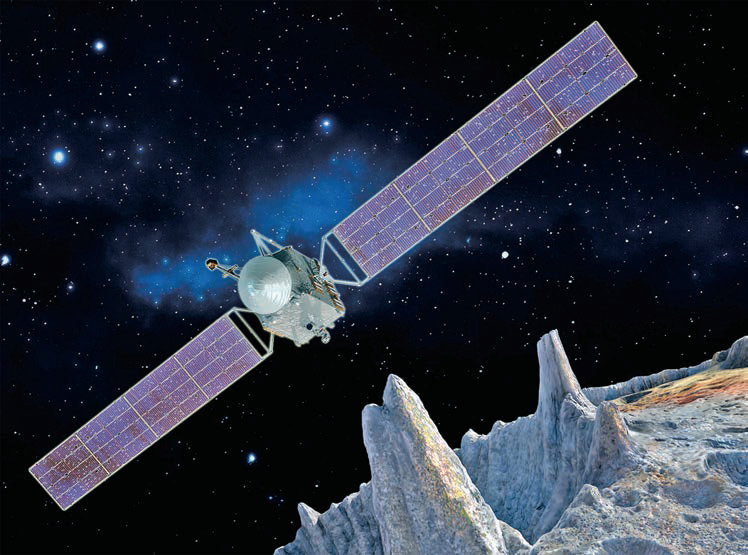
Artistic rendition of the Psyche spacecraft. Image is courtesy of SSL/ASU/P. Rubin/NASA JPL-Caltech.
SSL will work for NASA’s Jet Propulsion Laboratory (JPL) to support Principal Investigator Dr. Lindy Elkins-Tanton, director of Arizona State University’s (ASU) School of Earth and Space Exploration, in a mission to research the 210 km diameter asteroid, which is believed to be the only place in the solar system where a metal planetary core can be studied.
As the industrial partner, SSL will provide the “power-propulsion chassis,” a highly capable composite structure spacecraft platform equipped with a high-power solar electric propulsion (SEP) system.
The NASA Discovery Program goal is to deepen the knowledge of our solar system by launching modest cost-capped missions on a routine cadence.
Scheduled to launch in the 2020s, the Psyche mission was selected for flight out of five Discovery Mission candidates.
The spacecraft design is based on the SSL 1300 platform, which has been proven on more than 100 missions, and has the flexibility to serve a broad range of applications, ranging from space exploration and remote sensing, to commercial communications.
SSL is also contributing to a variety of other next generation US government missions, including the Restore-L mission for NASA’s Goddard Space Flight Center, which will demonstrate the ability to extend the life of a satellite in Low Earth Orbit (LEO), and the Dragonfly program for NASA and DARPA, which will demonstrate on orbit satellite assembly.
“Our many years of experience and success in building state of the art spacecraft, position us well to support NASA programs and to contribute to this NASA Discovery Mission,” said John Celli, president of SSL.
He added that the firm’s partnership with ASU and JPL will enable this ground breaking research, which will help with a better understand of the early days of the solar system and the formation of terrestrial planets.
According to the JPL infosite, 16 Psyche is about three times farther away from the sun than is the Earth. This asteroid measures some 130 miles (210 kilometers) in diameter and, unlike most other asteroids that are rocky or icy bodies, is thought to be comprised mostly of metallic iron and nickel, similar to Earth’s core.
Scientists wonder whether Psyche could be an exposed core of an early planet that could have been as large as Mars, but which lost its rocky outer layers due to a number of violent collisions billions of years ago.
The mission will help scientists understand how planets and other bodies separated into their layers—including cores, mantles and crusts—early in their histories.
“This is an opportunity to explore a new type of world - not one of rock or ice, but of metal,” said Psyche Principal Investigator Lindy Elkins-Tanton of Arizona State University in Tempe. “16 Psyche is the only known object of its kind in the solar system, and this is the only way humans will ever visit a core. We learn about inner space by visiting outer space.”
Psyche, also a robotic mission, is targeted to launch in October of 2023, arriving at the asteroid in 2030, following an Earth gravity assist spacecraft maneuver in 2024 and a Mars flyby in 2025.
sslmda.com/
jpl.nasa.gov/
Multi-Band Comms For Stena Line from Marlink
Marlink has added the first out of four additional Stena Line ships to the firm’s multi-band communications network.
Marlink now serves the entire fleet of Stena Line vessels, ensuring high levels of connectivity for passengers and crew, in addition to operational applications and commercial businesses on board. Marlink will also further increase available capacity to Stena Line vessels with an additional 10 to 15 percent, following the tripled bandwidth increase in June 2016. As one of the largest ferry operators in Europe and the world, more than 7 million people a year travel to their destination with Stena Line.
The company defines on board communications as a critical passenger satisfaction indicator so it is committed to offering the best available technology and services for its customers. Stena Line is today well recognized as an early adopter of new communication services, having worked closely with Marlink since the mid-nineties to introduce several ‘firsts’ in the world of maritime communication; including paving the way for multi-band networks that deliver high availability, redundancy and value for money.
Marlink has developed one of the most advanced multi-band networks for the Stena Line fleet, based on seamless integration of VSAT and GSM 3/4G services for connectivity during voyages in addition to in-port Internet Wi-Fi networks. The service was upgraded this summer, with three times more bandwidth added to the Stena-Line ‘Closed User Group’ (CUG), which guarantees bandwidth availability and flexibility for all vessels in the network.
The capacity in Stena Line’s dedicated CUG will be increased by a further 10 to 15 percent early in 2017. Stena Line’s industry leading multi-band solution enables high availability of voice and Internet, serving hundreds of passengers simultaneously. With a pool of bandwidth reserved just for the Stena Line fleet, the CUG also provides the flexibility to optimize connectivity based on current demands of the fleet. Stena Line vessels receiving connectivity within 3/4G coverage areas or Wi-Fi while in port will require less from the VSAT CUG capacity, allowing even more satellite bandwidth to be available for other vessels and passengers at sea. Switching between VSAT, 3/4G and port Wi-Fi services when docked is seamless, allowing passengers and businesses on board to benefit from reliable multi-band Internet connectivity that can be relied upon throughout a voyage.
marlink.com/
stenaline.com/
GreDom-Insert from RUAG Space is a Real Winner
An invention in the area of satellite construction by the University of Applied Sciences and Arts, Northwestern Switzerland FHNW, with support from its industrial partner, RUAG Space, has been awarded the 2016 YPSOMED Innovation Prize—the automation process subsequently developed on the basis of this invention contributed to RUAG Space acquiring a major project.
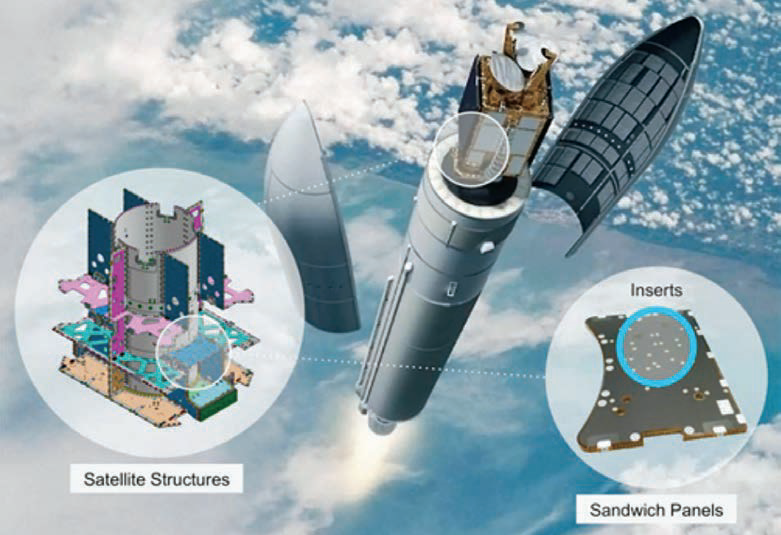
Sandwich panel with inserts as part of a satellite structure. Image is courtesy of RUAG Space.
The 2016 YPSOMED Innovation Prize went to the development of the “GreDom-Insert.” This is a novel kind of insert that is installed and bonded in satellite panels fully automatically.
These are special thread inserts which allow instruments, assemblies and sensors to be attached to the load-bearing structure of a satellite. An average communications satellite has between 5,000 and 10,000 inserts, which have had to be installed manually up to now.
When presenting the 2016 YPSOMED innovation prize, Professor Peter Mürner, Trustee of the YPSOMED Innovation Fund, summed up the jury’s decision as follows: “This invention produced at FHNW is a perfect example of targeted, innovative and forward-looking collaboration between research and business.”
Based on the “GreDom” insert developed at FHNW, and on the findings of this research project funded by the Commission for Technology and Innovation (CTI), RUAG Space then designed and built the “Automated Potting Machine.”
This automatically cuts panels to size, drills holes, applies adhesive and places the inserts into the panel with a high degree of precision.
The manufacturing time for satellite structures can thus be significantly reduced, enabling considerable cost savings.
This revolutionary invention provides an instant benefit for the industrial partner RUAG Space.
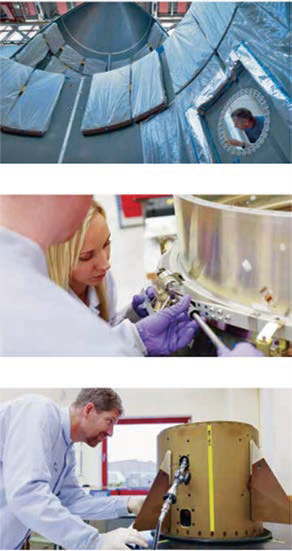
“The fact that we have been awarded the contract to construct the OneWeb satellite structure is partly due to this automated manufacturing process. Our efficiency means we stand out from the competition,” according to Urs Breitmeier, CEO of RUAG.
For this major project, a total of 900 satellites should provide blanket broadband Internet by the end of 2020 and this is the largest series production in the history of satellite construction.
Product development for the space industry is one of the FHNW School of Engineering’s focus areas.
The School’s 14 institutes work closely together with the business sector on applied research and development.
The inventors of the revolutionary “GreDom” insert are Prof. Gregor Burkhard (FHNW) and Dominik Nägeli (previously FHNW, now RUAG Space).
Their invention was developed further by the project team with FHNW researchers Laurent Repond, Marcel Gloor and Stefan Kobler, under the leadership of Prof. Hans-Peter Gröbelbauer (FHNW) and Stefan Kögl (previously RUAG Space).
The research project was funded by the Commission for Technology and Innovation CTI.
The YPSOMED Innovation Fund Foundation aims to motivate creative and innovative teams or individuals to incorporate the needs of industry and services in their academic work.
The projects presented should therefore contain innovative, financially feasible ideas, products, procedures, methods or services.
Together with the award, the winner of the YPSOMED Innovation Prize receives CHF 30,000 in prize money.
ruag.com
KVH Upgrades and Plans to Include IoT and OneWeb
At the 19th Annual Needham Growth Conference in New York, KVH CEO Martin Kits van Heyningen announced that his company is initiating an upgrade to mix high-throughput capacity from geostationary and LEO satellites into its network that will triple current speeds.

KVH CEO Martin Kits van Heyningen
He added that they will launch a new high-capacity network using Ku-band spot beam satellites that have a capacity up to 60 gigabits per second, which is a huge improvement over the technology that was available before.
This has been his ambition for a number of years, offering higher speeds at approximately the same current price for his customers when factoring in the additional pricing pressure exerted by oversupply.
KVH uses 19 satellites and 12 teleports to support a global C- and Ku-band network for maritime vessels.
Kits van Heyningen estimated the company’s addressable market at about 250,000 vessels, of which he estimated less than 10 percent use Very Small Aperture Terminals, or VSATs, currently for connectivity, which will be changing.
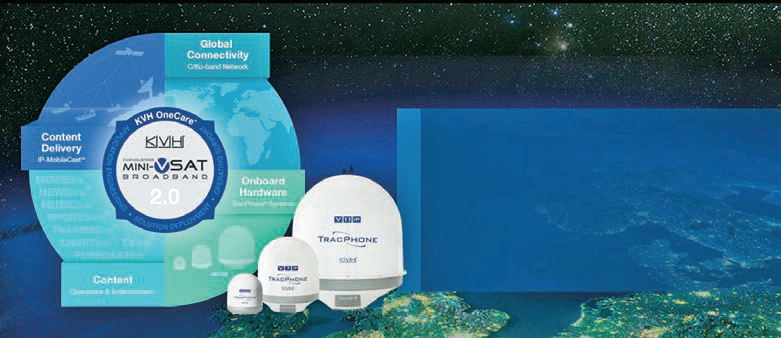
“We are at the beginning of a major upgrade cycle in this market. The technology that has been used is over 10 years old now,” he said. “L-band satphone-type technology is really no longer adequate for modern operations, but about 40,000 vessels are still using that, and those are getting speeds that are in kilobits per second, not in megabits per second. We see a lot of those customers upgrading to VSAT over the next few years.”
KVH manufactures satellite terminals and other equipment and currently is preparing new terminals simultaneously with the planned network upgrade so users can tap into geostationary HTS this year.
Kits van Heyningen said there will be an easy upgrade path for existing customers to tap into the higher speed services, but that it will not be mandated.
“It is a little bit like 3G, if you want to stick to that network, you’re fine, but if you want the higher speeds, there is an upgrade path both for the install base as well as for new customers,” he said.
Beyond geostationary-HTS the company is developing antennas to link with LEO systems especially OneWeb as well as for cellular backhaul systems.
He said maritime antennas already have traits needed to connect with LEO systems because they are designed to track with a satellite while in motion.
Other projects include developing an Internet of Things (IoT) product to optimize maritime operations, to assist with new regulations that require carbon dioxide emissions reporting from maritime vessels, that entails operators tracking new data.
kvh.com



